#Mineral Ingredients Industry
Text
Global Mineral Ingredients market Size Expected To Reach USD 16800 Million With CAGR 5.60% By 2030

The Global Mineral Ingredients market size was reasonably estimated to be approximately USD 11200 Million in 2023 and is poised to generate revenue over USD 16800 Million by the end of 2030, projecting a CAGR of around 5.60% from 2023 to 2030.
The mineral ingredients market is witnessing robust growth driven by the increasing awareness of health and wellness, coupled with the rising demand for functional and fortified foods. As consumers become more conscious of their dietary choices, the importance of essential minerals in promoting overall well-being has gained prominence. This market encompasses a wide range of minerals, including but not limited to calcium, magnesium, iron, zinc, and selenium, which find applications in various industries such as food and beverages, pharmaceuticals, and cosmetics.
The food and beverage industry holds a significant share in the mineral ingredients market, with a growing emphasis on developing products that not only satiate taste preferences but also contribute to nutritional requirements. Additionally, the pharmaceutical sector is integrating mineral ingredients into supplements, recognizing their pivotal role in preventing and addressing mineral deficiencies. As the global population continues to grow and age, the demand for mineral ingredients is expected to rise, presenting lucrative opportunities for market players.
Leading players involved in the Mineral Ingredients Market include:
"BASF, Cargill, DuPont, Lonza, Pfizer, Cognis , Koninklijke DSM N.V, Arla Foods Amba, Akzonobel N.V., Balchem Corporation, Minerals Technologies Inc, Gadot Biochemical Industries Ltd, Yara International ASA, Jungbunzlauer Suisse AG, Compass Minerals International Inc,Corbion N.V and Other Major Players."
Get Sample Report: -
The latest research on the Mineral Ingredients market provides a comprehensive overview of the market for the years 2023 to 2030. It gives a comprehensive picture of the global Mineral Ingredients industry, considering all significant industry trends, market dynamics, competitive landscape, and market analysis tools such as Porter's five forces analysis, Industry Value chain analysis, and PESTEL analysis of the Mineral Ingredients market. Moreover, the report includes significant chapters such as Patent Analysis, Regulatory Framework, Technology Roadmap, BCG Matrix, Heat Map Analysis, Price Trend Analysis, and Investment Analysis which help to understand the market direction and movement in the current and upcoming years. The report is designed to help readers find information and make decisions that will help them grow their businesses. The study is written with a specific goal in mind: to give business insights and consultancy to help customers make smart business decisions and achieve long-term success in their particular market areas.
Market Driver:
One of the primary drivers propelling the mineral ingredients market is the increasing prevalence of health-conscious consumer behavior. As lifestyles become more fast-paced and stressful, there is a growing realization of the need for a balanced diet to maintain optimal health. Minerals play a crucial role in various physiological functions, including bone health, immune system support, and energy metabolism. This heightened awareness among consumers regarding the benefits of minerals is encouraging the incorporation of mineral-rich ingredients into daily diets.
The rise in chronic health conditions, such as osteoporosis and anemia, has further accentuated the importance of mineral supplementation. This has led to a surge in demand for food and beverage products fortified with essential minerals, driving innovation and product development in the market. The increasing focus on preventive healthcare and the pursuit of a holistic approach to well-being are fostering the growth of the mineral ingredients market.
Market Opportunity:
An exciting opportunity within the mineral ingredients market lies in the development of personalized nutrition solutions. With advancements in technology and an increasing understanding of individual health needs, there is a growing trend toward personalized diets and nutritional plans. Mineral ingredients, with their diverse range of health benefits, can be tailored to meet specific nutritional requirements based on factors such as age, gender, and health conditions.
The integration of mineral ingredients into personalized nutrition programs presents a unique opportunity for market players to differentiate their products and cater to the evolving demands of consumers. Customized mineral formulations, backed by scientific research, have the potential to not only address prevalent health issues but also contribute to preventive healthcare. As consumers seek more tailored approaches to nutrition, leveraging this opportunity can position companies at the forefront of innovation in the mineral ingredients market.
If You Have Any Query Mineral Ingredients Market Report, Visit:
Segmentation of Mineral Ingredients Market:
By Type
Macronutrients
Micronutrients
By Form
Liquid
Powder
Others
By Application
Bakery & Confectionery
Food Supplements
Ready to Eat Foods
Cosmetics & Personal Care
Pharmaceuticals
Others
An in-depth study of the Mineral Ingredients industry for the years 2023–2030 is provided in the latest research. North America, Europe, Asia-Pacific, South America, the Middle East, and Africa are only some of the regions included in the report's segmented and regional analyses. The research also includes key insights including market trends and potential opportunities based on these major insights. All these quantitative data, such as market size and revenue forecasts, and qualitative data, such as customers' values, needs, and buying inclinations, are integral parts of any thorough market analysis.
Market Segment by Regions: -
North America (US, Canada, Mexico)
Eastern Europe (Bulgaria, The Czech Republic, Hungary, Poland, Romania, Rest of Eastern Europe)
Western Europe (Germany, UK, France, Netherlands, Italy, Russia, Spain, Rest of Western Europe)
Asia Pacific (China, India, Japan, South Korea, Malaysia, Thailand, Vietnam, The Philippines, Australia, New Zealand, Rest of APAC)
Middle East & Africa (Turkey, Bahrain, Kuwait, Saudi Arabia, Qatar, UAE, Israel, South Africa)
South America (Brazil, Argentina, Rest of SA)
Effective Points Covered in Mineral Ingredients Market Report: -
Details Competitor analysis with accurate, up-to-date demand-side dynamics information.
Standard performance against major competitors.
Identify the growth segment of your investment.
Understanding most recent innovative development and supply chain pattern.
Establish regional / national strategy based on statistics.
Develop strategies based on future development possibilities.
Purchase This Reports: -
About Us:
We are technocratic market research and consulting company that provides comprehensive and data-driven market insights. We hold the expertise in demand analysis and estimation of multidomain industries with encyclopedic competitive and landscape analysis. Also, our in-depth macro-economic analysis gives a bird's eye view of a market to our esteemed client. Our team at Pristine Intelligence focuses on result-oriented methodologies which are based on historic and present data to produce authentic foretelling about the industry. Pristine Intelligence's extensive studies help our clients to make righteous decisions that make a positive impact on their business. Our customer-oriented business model firmly follows satisfactory service through which our brand name is recognized in the market.
Contact Us:
Office No 101, Saudamini Commercial Complex,
Right Bhusari Colony,
Kothrud, Pune,
Maharashtra, India - 411038 (+1) 773 382 1049 +91 - 81800 - 96367
Email: [email protected]
#Mineral Ingredients#Mineral Ingredients Market#Mineral Ingredients Market Size#Mineral Ingredients Market Share#Mineral Ingredients Market Growth#Mineral Ingredients Market Trend#Mineral Ingredients Market segment#Mineral Ingredients Market Opportunity#Mineral Ingredients Market Analysis 2023#US Mineral Ingredients Market#Mineral Ingredients Market Forecast#Mineral Ingredients Industry#Mineral Ingredients Industry Size#china Mineral Ingredients Market#UK Mineral Ingredients Market
0 notes
Text
Green energy is in its heyday.
Renewable energy sources now account for 22% of the nation’s electricity, and solar has skyrocketed eight times over in the last decade. This spring in California, wind, water, and solar power energy sources exceeded expectations, accounting for an average of 61.5 percent of the state's electricity demand across 52 days.
But green energy has a lithium problem. Lithium batteries control more than 90% of the global grid battery storage market.
That’s not just cell phones, laptops, electric toothbrushes, and tools. Scooters, e-bikes, hybrids, and electric vehicles all rely on rechargeable lithium batteries to get going.
Fortunately, this past week, Natron Energy launched its first-ever commercial-scale production of sodium-ion batteries in the U.S.
“Sodium-ion batteries offer a unique alternative to lithium-ion, with higher power, faster recharge, longer lifecycle and a completely safe and stable chemistry,” said Colin Wessells — Natron Founder and Co-CEO — at the kick-off event in Michigan.
The new sodium-ion batteries charge and discharge at rates 10 times faster than lithium-ion, with an estimated lifespan of 50,000 cycles.
Wessells said that using sodium as a primary mineral alternative eliminates industry-wide issues of worker negligence, geopolitical disruption, and the “questionable environmental impacts” inextricably linked to lithium mining.
“The electrification of our economy is dependent on the development and production of new, innovative energy storage solutions,” Wessells said.
Why are sodium batteries a better alternative to lithium?
The birth and death cycle of lithium is shadowed in environmental destruction. The process of extracting lithium pollutes the water, air, and soil, and when it’s eventually discarded, the flammable batteries are prone to bursting into flames and burning out in landfills.
There’s also a human cost. Lithium-ion materials like cobalt and nickel are not only harder to source and procure, but their supply chains are also overwhelmingly attributed to hazardous working conditions and child labor law violations.
Sodium, on the other hand, is estimated to be 1,000 times more abundant in the earth’s crust than lithium.
“Unlike lithium, sodium can be produced from an abundant material: salt,” engineer Casey Crownhart wrote in the MIT Technology Review. “Because the raw ingredients are cheap and widely available, there’s potential for sodium-ion batteries to be significantly less expensive than their lithium-ion counterparts if more companies start making more of them.”
What will these batteries be used for?
Right now, Natron has its focus set on AI models and data storage centers, which consume hefty amounts of energy. In 2023, the MIT Technology Review reported that one AI model can emit more than 626,00 pounds of carbon dioxide equivalent.
“We expect our battery solutions will be used to power the explosive growth in data centers used for Artificial Intelligence,” said Wendell Brooks, co-CEO of Natron.
“With the start of commercial-scale production here in Michigan, we are well-positioned to capitalize on the growing demand for efficient, safe, and reliable battery energy storage.”
The fast-charging energy alternative also has limitless potential on a consumer level, and Natron is eying telecommunications and EV fast-charging once it begins servicing AI data storage centers in June.
On a larger scale, sodium-ion batteries could radically change the manufacturing and production sectors — from housing energy to lower electricity costs in warehouses, to charging backup stations and powering electric vehicles, trucks, forklifts, and so on.
“I founded Natron because we saw climate change as the defining problem of our time,” Wessells said. “We believe batteries have a role to play.”
-via GoodGoodGood, May 3, 2024
--
Note: I wanted to make sure this was legit (scientifically and in general), and I'm happy to report that it really is! x, x, x, x
#batteries#lithium#lithium ion batteries#lithium battery#sodium#clean energy#energy storage#electrochemistry#lithium mining#pollution#human rights#displacement#forced labor#child labor#mining#good news#hope
3K notes
·
View notes
Note
Hey! I saw an earlier post you had about the boys in the grocery store and it got me wondering about how they would react to hunting. I’m a hunter, have been all my life. I hunt deer, boars, ducks, coyotes, turkeys, quails, pheasants, wild Burmese pythons, and I fish locally too (strictly a vermin exterminator and food hunter, I find sports hunting to be distasteful and I strictly use a bow and arrow, no traps or guns as I take issues with those too). I can picture the absolute horror of the TFP or Lost Light bots seeing their/a human skinning and processing an animal that they just hunted for food, they see the modern convinces that are grocery stores so it’s easy to forget where human food actually comes from 😂
Weirdly enough, IDW/MTMTE does have Cybertronian edibles like cesium salami and rust sticks.
But then again, there's a big percentage of the crew members who were produced by the war, so there's a great chance that they didn't get a crash course on things that were deemed "unnecessary," like Cybertronian cuisine and fauna to forage and hunt.
TFP Cybertronians, on the other hand, have Questions.
Get ready to pull up diagrams, manuals, videos, and live demonstrations via YouTube or your own hands because they got the curiosity of two-year-old with the capacity to keep you in their palm for no escape.
Ratchet absolutely hates it. It's too messy and squishy and completely unalike the organized and relatively clean method of converting crystals to fuel. Horrified over the mysteries of hotdogs and how everything can and will kill humans without specific preparations to negate the toxins. Ratchet is boggled over spice challenges and how the hell humanity hadn't died in its infancy over culinary explorations. Someone told him to look up Hákarl.
He takes great displeasure when the kids sass him over Cybertronians eating their own blood. Different. Absolutely different. He clucks over the base kitchen and is not above making things disappear. He argues with June and Agent Fowler over the groceries and fast food bags. Ratchet's crunchy.
Bulkhead actually enjoys fishing. He's more catch and release rather than for keeping and gutting. He likes soaking up the heat of the sun, the sound of running water, birdsong, and insects buzzing, the gear setup and picking out the right lure and bait. It's a different kind of downtime, but it's nice. All he's missing is engex, but he's able to throw a line farther out than anyone else and has the capability to detect motion far greater than an average human. He still wants an engex cube.
Arcee has mixed feelings. She enjoys hunting. Patience, tracking, stealth, and the sense of accomplishment with a clean catch. She likes less the process of handling carcasses, but really hates waste anything that could have been useful. Meat, leather, tools, jewelry, and raw ingredients that could be sold or traded. Arcee just doesn't like sharing something with Airachnid's methods.
Bumblebee's a scout. People expected him to like foraging or the wilds. He prefers domesticated stock. In particular, beekeeping. To him, it represents a more equivalent partnership: he provides accessible resources and safe quarters and the bees yield honey, comb, and wax in return. If the hive don't like him or the area, then they can leave elsewhere.
Optimus is deeply fascinated by how Earth's biodiversity is so immense and how ecosystems are so diverse and complex, yet so fragile. He quietly wishes for Alpha Trion's presence because Optimus is seeing familiar similarities of Cybertronian long gone biomes: wetlands, woodlands, and reefs. The Sea of Rust once was a massive ocean of mineral-laden Energon. It has long since disappeared by the consensus of heavy, unregulated industrialization, but if Earth has the water cycle, ocean currents and belts, and complex system of thermoregulation that replenishes itself, then Cybertron had to have something similar at one point, no?
#ask#transformers#transformer prime#tfp#optimus#optimus prime#ratchet#bulkhead#arcee#bumblebee#culture clash#cybertronian culture#maccadam#my writing#look Ratchet is completely scandalized and crunchy#Optimus would watch too many nature docs and try to fish exactly like a bear#the autobots get fascinated by cooking shows tho
76 notes
·
View notes
Note
Hello! I love your blog bc it helps me a lot with writing and crafting. Thank you so much for making it!
Are there any patterns that deal with poison? Either in the pattern or in the dyeing process?
Even if there's not I'm glad you and this blog exist 💗
(anon continues) Poison in the dyeing process, like when green dresses were dyed with copper arsenite and it was extremely deadly.
Or a pattern of someone being poisoned, like a historical/folktale.
_______________________________________
Thank you for your kind words <3 I tried to keep things organized but the subject is huge so my of the top of my head answer is going in many directions. I hope you'll still find what you need :3
I'll briefly cover here dyes and (pigments), poison motifs, real life and supernatural poisonings. Buckle up we've got a long post ahead!
____ ABOUT DYE
Tbh I had to think for a moment because I don't recall major "poison" stories linked to dyes in Japan, be it fictionous or real (yet that doesn't mean none ever happened, especially considering Japan's history of industrial poisonings...).
Most gruesome details in the fabric industries I know of are about the horrific life & work conditions of female laborers in spinning mill manufactures (as in many countries, Japan industrialization process was ghastly...).
If potters and dyers had excellent practical knowledge, chemistry as a science officially started kind of late in Japan as it was not a local interest, and as rangaku (study of Western knowledge) often favored other subjects like medicine or warfare.
So, until the introduction of aniline dyes (not textile related, but this article about the use of synthetic dyes in ukiyoe printing is super interesting), Japanese worked with "natural" dyes, like ai (indigo) which was the most used during Edo period.
As with any ingredient, being natural doesn't equal safety. Some mixtures could be quite potent/foul, and process could be dangerous. Plants and minerals base ingredients could be toxic (cinnabar and orpiments were then used as paint pigments, and lead could be found in make up), as were mordants used to set colors.
If you want to easily overview which ingredients were used to create colors, I recommand browsing [Irocore] which presents colors with explanation in English in their database (pick a color then scroll down).
Not related to poison, but ai (indigo) is traditionally prepared in aigame/enormous floor set jars I find utterly terrifying:

I don't know if this tidbit can help you, but some dyes and mordants actually damage the fabric overtime, leaving them brittle (silk desintegrates after a while which is a huge issue in textile conservation).
____ POISON MOTIFS
Concerning "poison" themed patterns, none would be actually used traditionally on a kimono or an obi beside novelty items ^^;
For example, many plants can be toxic, but I don't see them set as pattern for this property - they'd rather refer to a poem, be a symbol of the passing of seasons etc. Fuji (wisteria) can be quite harmful, yet it's a beloved traditional motif in Japan.
You have much more chances to find pattern with kujaku (peacock) which are thought to be impervious to poison in Buddhism, than say venomous mukade (centipede) or the horrific ômukade (a youkai I covered in a folktale).
Snakes like the habu and mamushi are dangerous, but if used as pattern snakes are most often auspicious and linked to rain dragons or goddess Benzaiten.
If you squint hard, toxic fugu could count as poison pattern, but such a seasonal delicacy as a motif would mostly underline wealth (as those fishes are pretty expensive as they are prepared by specialized chefs), a kind of carpe diem spirit, or just a fun pattern because fugu balloon shape is cute ;)

____ POISON MURDERS
Poisoning was certainly a thing is Japan since ancient times (see kodoku sorcery). Poisons were for example used in some fishing techniques.
I am pretty sure some kuge and buke were disposed of this way - even thought poison was seen as a coward weapon (hence why its supposed to be only used by shinobi/ninja - even if this "fact" is opened to a lot of discussions!).
During Edo period, such murders made up the news and penny dreadful-like illustrated books favored by city dwellers in need of a fright. But those stories didn't pass to posterity beside cheap ukiyoe plates, and were never as popular as some shinjû (double suicides) or ghost revenges like poor poisoned and murdered Oiwa's:

____ SUPERNATURAL POISONINGS
If your poison is both physical and metaphorical illbeing, mushi could be your guys ^^ This term actually covers everything small and crawling, from real worms and insects, to anything inside one's body causing distress - be it a parasite, an unknown illness, an overboard emotion, a curse etc. If you've read/seen Mushishi you've got what I mean:

In fact any illness-causing being could count as poison-bringer. Hôsôkami (smallpox demon) was truly feared by all before vaccination was introduced in Japan.
Finally, continuing the supernatural poisoning trail, best girl is probably legendary fox witch Tamamo no Mae who among other terrible deeds made emperor Konoe fall sick with poisonous miasma (some version of the story attributes the disease to another monster, the nue). I covered a similar murderous kitsune folktale here.
#ask#japan#japanese history#dye#pattern#motif#poison#venomous#illness#natural dye#aniline dye#mordant#pigment#kujaku#peacock#mukade#centipede#omukade#youkai#snake#hebi#mamushi#habu#benzaiten#fugu#mushi#insect#mushishi#Hôsôkami#smallpox demon
116 notes
·
View notes
Text
Intermediate Kitchen Witchcraft: Nutrition
The ideas of nutrition and healthy eating have been corrupted by the diet industry. Auntie says fuck that. Think of nutrition as a matter of nutrients. Don’t take, don’t deprive. Add to your body!
For intermediate witchcraft, think of things as macronutrients (big) and micronutrients (small). A macronutrient is what your body uses the most of, while a micronutrient is what your body uses a smaller amount of.
Macronutrients are: protein, fat, and carbohydrates. Your body needs all three of them - yes, even fat and carbs. Fuck what the diet industry told you and listen to Auntie: it is not only ok to eat fat and carbs, it is actively a good thing.
Micronutrients are: vitamins and minerals. Your body is a gloriously complex, divine structure that requires a steady supply of the Earth’s bounty to thrive. You can use these amazing things She has given us to improve your body and your mind. Use what She gives you!
Let’s take a look at some common magical ingredients and the micronutrients they give you! This will help provide you with a greater understanding of how to use them to craft your kitchen spells. Magical properties are purple, practical are pink.
Cinnamon: Healing, protection, warmth, love, prosperity. Vitamins A, B, C, K; calcium; magnesium; potassium; phosphorus. Useful in lowering blood pressure, high in antioxidants, can improve insulin sensitivity, protects against heart disease, powerful anti-inflammatory. Connect the practical value to the magical value. What do you think corresponds? The one that jumps out to me is love corresponding to heart health.
Lemons: Purification, cleansing, joy. Extremely high in Vitamin C; fiber; B6; potassium. Lowers your risk of kidney stones, antiseptic properties, big immune booster. Once again, compare the practical and magical uses. I see vitamin B6 connecting to joy - B vitamins are known to improve stress responses.
Arugula: Attraction, abundance, sex magic, psychic powers. Potassium, calcium, folate; vitamins B, C, D, K, and A. Calcium & vitamin D work together for bone health; eye health; high in antioxidants; improves iron absorption; contains many elements shown to reduce cancer risks. I see a connection in iron absorption and sex magic.
Now, while these are a very direct nutrient-to-association correlation, we do also need to remember that there are other factors. Taste is a huge factor in kitchen magic! Cinnamon associates to a warm disposition; cinnamon is a hot food. Lemons are a sunny food. Arugula is easy to grow, therefore it is abundant.
Homework:
Comment below with your connections on the ingredients listed above. OR
Choose your favorite magical ingredient and reblog it with an analysis of how its magical properties correlate to its practical properties. Feel free to delve into some of the other connections too!
#witchcraft#witch#witchy#kitchen witch#witchblr#witchy community#witches of tumblr#witch tips#intermediate witch#intermediate witchcraft
171 notes
·
View notes
Text
Transparency With Parrot Food Manufacturers
There's been a significant rise in the expectation of transparency between pet food manufacturers and the general public. Dog food manufacturers, for example; have AAFCO, feeding trials, and an array of nutrient digestibility charts, base nutrient expectations, and sanitary guidelines to follow which a lot of brands then openly share with the public. These standards help pet parents make more active choices in what they feed their pets, tailor their pets diet to meet their individual needs, trust that their food meets a base line of nutrition, and that the food was produced in a sanitary manner. The dog food industry is far from perfect and even these regulations have their flaws and the tests aren't without fault but it is a good base for us to compare to when we're trying to sort out what we want from other pet food manufacturers. In this case I'm focusing on parrot pellet manufacturers.
I had a few different goals heading in to this.
I wanted to see how transparent pellet manufacturers would be with sharing information that is common to ask dog food manufacturers (information is not confidential, revealing formulas, secrets, etc.)
The availability of nutrient analysis charts (breakdowns of how much of each nutrient is in their pellets)
What standards parrot food manufacturers held themselves to
If any feeding trials were performed on their pellets
And to preface this with my own bias, I am pro-pellet, I currently feed pellets.
Before we get too deep in to this let's break things down a bit.
As it stands there really aren't any regulating bodies above parrot food manufacturers as far as I could find. There doesn't seem to be much of any standards when it comes to their sanitization or product quality, the best you get is the FDA/ CFIA which basically just make sure a food isn't outright toxic. As it stands there haven't been enough studies done on parrot nutrition for there to be a governing body stating what the minimum nutrient requirements are for parrot food, we simply do not actually know what those requirements are yet so there cannot be a set standard for it. This unfortunately leaves us open to a lot of problems, if there's no nutritional requirements and no standardized testing then we're really just putting a lot of trust in to a company that wants to turn a profit. We're hoping that the food that says it's nutritionally complete is what it says with no evidence to show for it, and no science to confirm it.
So with that said no parrot food can actually claim to be "100% nutritionally complete", we do not know what nutritionally complete looks like for parrots, there is no science to back up those claims.
So I set out and emailed every parrot pellet manufacturer I could think of and asked them the some questions.
"Does your company do feeding trials? If so, is that data available to the public anywhere?"
"Do you have a nutrient profile available?"
Feeding trials are very simply a test where you feed a set of animals exclusively one diet and then monitor them to see if the food is capable of providing the base essential nutrients needed to live. Usually they do blood work, urine and fecal alongside regular physical exams to monitor things like nutritional deficiency, ailments, and nutrient digestibility. This helps show that a food is capable of providing what the target animal needs to survive without causing health problems and provides vital information on what amount of vitamins/ minerals in the produced food are actually being digested and absorbed. These tests are common among well-known dog food companies and most are more than willing to share that data to give their consumers peace of mind with easy transparency.
And let me tell you I am beyond disappointed at what happened when I asked parrot food manufacturers the exact same thing.
TOPs: No nutrient profile listed on the website, does have a detailed breakdown of why every single ingredient was added though. Happily discloses that parrot nutritional science doesn't have all the data to claim any food as 100% nutritionally complete and advises for the feeding of fresh foods in addition to their food, didn't specify exactly how much of each to maintain optimal nutrition.
I emailed them three times and never got a response back from any of them.
Harrisons: Does say you can feed 20% vegetables by weight while the pellet should be 75%, has an easily available nutrient analysis on their website.
also emailed three times with no response back.
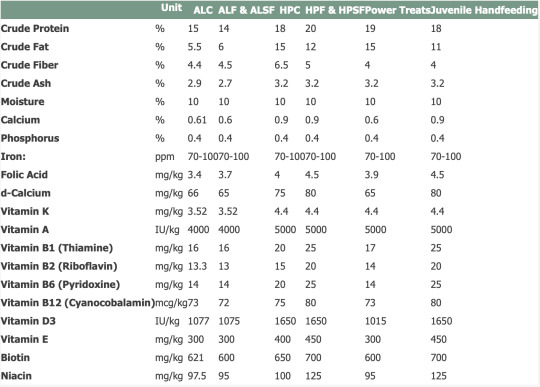
Caitec: no nutritional analysis listed on their main website, website did not state how they want their product to be fed, product packaging states that veggies should be a treat/ addition and lists the pellet as a "complete diet".
emailed three times with no response back.
Lafeber: Primarily promotes mixed seed and pellet formulas, doesn't state any risks of parrot's selective consumption (study on that problem), does promote the feeding of fresh produce in conjunction with their formulas at 20% of the diet, no nutrient analysis on their website.
emailed three times with no response back.
Zupreem (Compana Pet Brands): did respond back but they phrased their response in a way to dance around the subject, after some pushing they confirmed they do not do feeding trials. Encourages use of fresh foods with their formula, at least 60% pelleted diet recommended. Had an extremely small nutrient profile that just skipped over the important nutrient requirements like the Ca:Ph. I asked for a nutrient profile which they did not want to provide but were able to tell me that the naturals pellets have 0.59% calcium

Roudybush: Says fresh foods can be fed but "as a minor part of the diet", does say that science doesn't have enough information to make a product tailored to each species of bird, did make changes to their formula recently to remove menadione in favour of alfalfa due to it's potential toxicity. does seem to be evolving as science progresses. Ingredients list wasn't listed on the website, nor was a nutrient profile.
did not reply to any emails.
Tropican (HARI): I was hopeful for this one by the way their website boasts about their feeding trials and research. So so hopeful.
Talks about doing feeding trials openly on their website, recommends 70% pellet to 30% fresh foods (by caloric content not weight) but mentioned that their birds eat 100% pellets. Easily accessible albeit basic nutrient profile but it covers the main things.

After my email Mr. Hagen actually ended up calling me and what I was hoping would be a motivating call ended up being very hostile. Whenever I asked questions about data or results of a feeding trial I was immediately shut down, the topic was changed, I was interrupted mid-sentence over and over again. I was able to get small tidbits of info that were as vague as "we've fed multiple generations of birds on this food" and "we do annual weigh-ins". He would casually mention data from a study he had done but then dart away if I asked for the name of the study so I could read it later. It was an extremely off-putting phone call. Completely unwilling to say how many birds were in a trial, how many years the trial went on for, if there was bloodwork or nutrient digestibility charts, nothing at all. He also casually mentioned that once the birds are old enough they get sold to stores which was very unnerving to me.
So I guess they maybe do legitimate feeding trials but they will under no circumstances offer that data to the public? I don't know. They wouldn’t provide any published articles or data to actually prove that the trials exist and I will definitely not be contacting them again to find out. They suggested I was trying to steal their formula and lying about my identity. I'm not going to try to get a simple answer out of them again.
Mazuri: recommends 20% fresh foods 75% pellets, nutrient profile available on the website.
did not reply to any emails.

Pretty Bird: Does not do feeding trials, prompt to reply, at least knew what a feeding trial was. Couldn't find feeding recommendations on the website, no nutrient profile aside from the generic guaranteed analysis having a few add-ons but still skipping on the important nutrients you'd want to know about.

Kaytee: Did not know what a Feeding Trial was. Thought I wanted samples and offered me a coupon. I had to explain to this animal food manufacturer what a feeding trial was. Unsurprisingly they do not do feeding trials. Website had no listing of a nutrient analysis. Recommended 70-90% pellets to some fresh foods. In their own published article they went over how damaging seed diets are for parrots but then they also sell seed-only diets with the ingredients they were specifically bashing in their own article. When I asked for a nutrient profile this is what I was given:
"Nutrient levels are calculated based on ingredient data, feed compendium tables and direct diet analysis. Actual levels may vary slightly due to ingredient and analytical variation."
Kaytee exact naturals cockatiel pellet:
"0.4% Calcium
0.2% Available Phosphorus (non-phytate P)
0.1% Magnesium
120 ppm Zinc
140 ppm Iron
700 IU/kg Vitamin D3"
and that's just extremely limited information. I'm glad they were willing to provide something but in comparison to some of the others it's just not a lot of data.
Psittacus: advises for the use of grit in parrots, recommends 100% pellets but says you can feed a minimum of 70% to make room for fresh foods. Their response to feeding trails was really vague: "our products have been evaluated and tested in our centre as well as collaborating centres. This information is for internal use and it is not published anywhere". Wouldn't say what tests were done or elaborate further than that in any way. I then inquired for a detailed nutrient analysis chart saying that Mia's calcium has been a bit of a struggle (since it has been), curious if their brand may have more calcium than the ones Im using now to help her out to which they replied with "our food contains the calcium levels appropriate for him/her". (you literally cannot say that, you haven't run tests on my bird, you haven't worked with my vet regarding my bird, you cannot guarantee a blanket statement like that.). They did offer me a link to this catalogue which has more detailed info on their pellets production and a more thorough nutrient analysis chart.
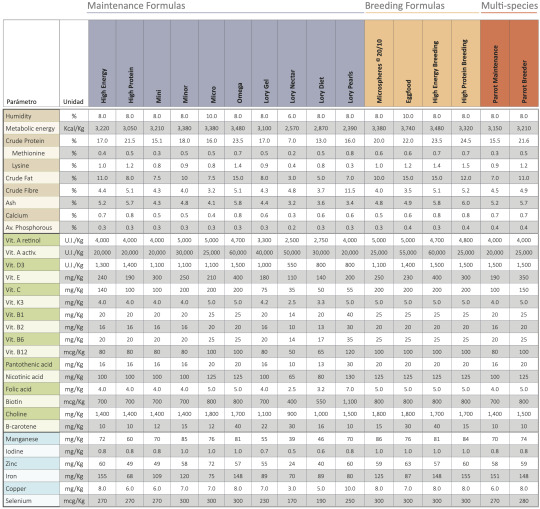
I am shocked by the responses I received. I am disappointed in parrot food manufacturers. I am frustrated with parrot food regulations.
I knew I wouldn't get much out of these emails since the standards for parrot food are so low but the amount of companies that just pretended not to get my emails or didn't even know what a feeding trial was is ridiculous. The amount of companies that were making claims that science can't back up, or making claims that science actually disagrees with is astounding.
The complete lack of transparency is terrifying.
#I am never doing this again#don’t ask questions to pet food companies they will try to throw you in jail#dude straight up was like WHAT WILL YOU DO WI THE THAT INFO YOURE NOT A VET???#HUH?????#feed my birds a diet that’s confirmed to be healthy for them……..#bring the data tm my vet and ask if this looks like a good option for my pets……#I will now be rethinking their diets entirely#thank you for coming to my ted talk#pellets#science
225 notes
·
View notes
Text
(the 3 most voted elements will advance onto the next round)
since there are a lot of unfamiliar faces I'll introduce each one under the cut:
(disclaimer: most if not all of these descriptions are copy-pasted or rephrased from Wikipedia. tell me if I miss anything or get anything wrong.)
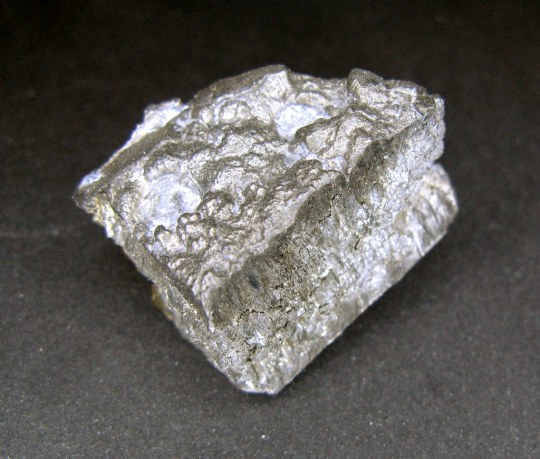
YTTRIUM is used in the red component of CRT TV color displays, in gas mantles for propane lanterns, to make synthetic garnets, and in some cancer treatments. It is also a key ingredient in a type of superconductor.

ZIRCONIUM is refractory, hard, and resistant to chemical attack. It is often used as an opacifier (to make something opaque) for ceramic materials and is sometimes used in space vehicles where heat resistance is needed. You may know him from the ZrO2 that is used for your laboratory crucibles. personally, I love crucibles. i will be kind of mad if zirconium gets no votes. crucible lovers unite.
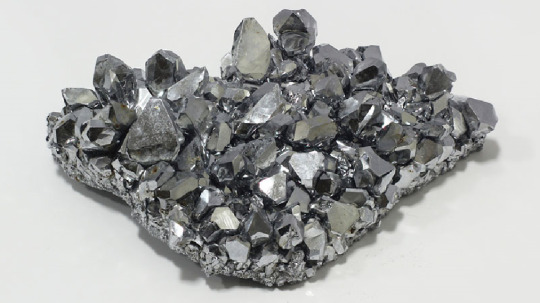
NIOBIUM is considered a technology-critical element. It is used mostly in alloys, and even in various superconducting materials, which are widely used for MRI scanners. and also they called this thing columbium for a while, and then confused it with tantalum. I'm glad they settled on niobium.
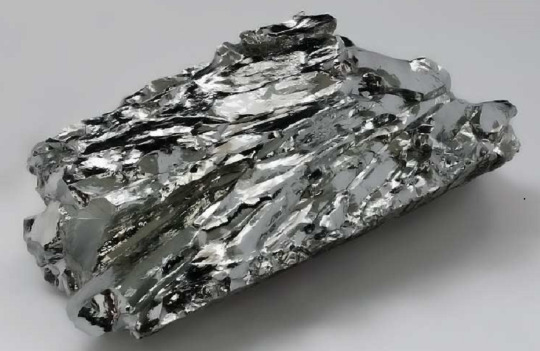
MOLYBDENUM is apparently an important mineral for the human body! Apparently, you should eat around 45 micrograms per day. Wow!!!!!!!!!

TECHNETIUM is the lightest element whose isotopes are all radioactive! It is often used in nuclear medicine, or generated as a fission product. They also took real long to find this guy, with 6 erroneous discoveries.

RUTHENIUM is also involved in many nuclear fission reactions, sometimes as a product of fission of uranium or plutonium. It's also used a lot in electronics due to its non-volatility.
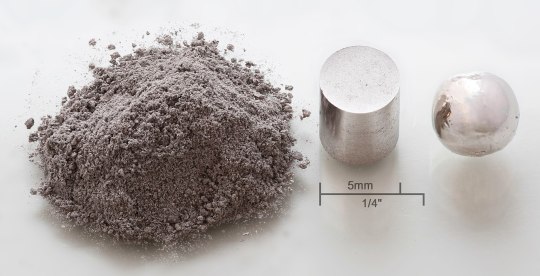
RHODIUM is a precious metal primarily used in catalytic converters for cars. It is also used for various other industrial processes. It is also used in jewelry, e.g. sometimes white gold is plated with rhodium to give it a shiny layer.

PALLADIUM is primarily used in catalytic converters for cars. Palladium is also used in electronics, dentistry, medicine, hydrogen purification, chemical applications, groundwater treatment, and jewelry. Palladium is also a key component of hydrogen-oxygen fuel cells.

SILVER: it's everywhere. it's even a whole color on its own. I've been using the word silver to describe the colors of every other element here. it's probably going to win.

CADMIUM: apparently this thing is toxic and carcinogenic despite having great potential in anticancer drugs. ah well. it was also used in batteries scarily recently.
24 notes
·
View notes
Text
redstone basics

Redstone is a magic-infused mineral found throughout the entire multiverse due to it's existence prior to Brother One & Two's fight. It can be found deep underground and is often identified through the unique, bright red glow it emits.
Despite being available in many different universes, redstone is primarily used in Brother Two's side of the multiverse (aka; the "minecraft" side). It's used in the mechanical process to create everything from giant industrial factories to communication devices to weapons of mass destruction.
Redstone itself is mainly used in its dust form as wiring thanks to it's special ability; using magic as a power source just as one would use electricity!
Redstone is also an ingredient in many crafting recipes for other types of machinery.
#hatake twins au#minecraft worldbuilding#✨ redstone ✨#for a Naruto crossover I sure have done more base Minecraft worldbuilding than anything else LOL#i promise other stuff is coming soon!
10 notes
·
View notes
Text
fun bit of trivia about my region of the states (north appalachia)
we have this food called pepperoni rolls (which i only learned a couple years ago are NOT ubiquitous across the country???)
they're pepperoni and sometimes a bit of mozzarella cheese rolled up in bread dough and baked, which makes the pepperoni grease/seasonings leach into the bread

everybody has their own method of rolling them and preferred size and preferred proportion of ingredients, but they tend to look something like this
they're often made in semi large batches, like a dozen or so
and they're good to eat warm, especially dipped in some marinara sauce
but more commonly, in the days after that, they're eaten cold/at room temperature. because the low moisture content and high salt and whatnot mean they can be left out of the refrigerator for several hours without spoiling
this made them extremely popular back when coal mining was the area's biggest industry. they could be packed in a miner's lunch box with no refrigeration and eaten for a decent source of protein. and similar went for steel millers and factory workers
and they just kinda became a regional staple over time from there
specifically, kids in school seemed to go hogwild for the things. like, our school band had, on top of standard bake sale type fundraisers, pepperoni roll sales. kids LOVED having Coal Miner Food in their lunches.
this is all to say: The Children Yearn For The Mines
#eliot posts#i do not remember for sure bc it was years ago and also i wasn't paying that much attention#but i THINK my friend john's dad might have been involved w the pepperoni roll sales???#if he did the baking then tbh yeah the hype makes sense. i've had his pepperoni rolls before them shits FUCK#honestly everything that man bakes/cooks that i've tried has been really good#jealous. not sure if i'm jealous of him for having those abilities or jealous of his kids for having a parent that can cook like that#but nonetheless
68 notes
·
View notes
Text
Don't Let the Packaging Get to You😭...
this is my follow-up on "2023 Is the Year to Become A Mindful Consumer"
We learn to buy things based on their packaging - the labels, the colors, graphics, etc. It gets both the logically minded and artistically minded alike. Looking beyond the packaging is not a matter of "not judging a book by its cover." It's important to outsmart the package's many ways of crying out "buy me!" Next thing you know, you've come home with a facial serum that breaks you out, a superfood powder that's 85% powdered rice grains, a drink you saw hyped up on TikTok, and a laundry detergent that claimed was "environmentally friendly" but the contents are just like the conventional brands. You might not even realize how many disappointing purchases you make like this. But if they fooled you, they've surely fooled others -- which fuels the company's marketing team to become more convincing & appealing.
First thing to address is your mentality when you enter a store or online shop. Realize that the point of the set-up is to get you to leave with as many products as possible, spending the most money possible, and leave with the thought of as many products as possible in your mind. If you struggle with sticking to just what you need, understand what is it about the store (its layout, employees, samples, etc) which cause you to be so easily convinced.
Next, understand what kind of customer you are. Place yourself in the shoes of a product marketer. What would you put on a package to sell it to yourself? How would you design that package? Who would you sponsor to convince you even further to buy that package? Look at the common denominators between the products you buy. Do you like going for the tried-and-true/popular brand, glam or sleek aesthetics, environmentally-friendly or ethical claims, more affordable option, latest trends, "doctor recommended" claims, or whatever else?
Also, understand what it means to make a purchase. Sure, everyone has heard that we vote with our dollars. But we don't always take full responsibility or power of our positions. Let's say that you like a product's contents except it's watered down with some waste product (like mineral oil), or you know that the company is deluding consumers with its claims & people are getting sick from it, or you learn that a shop aligns its aesthetics to look a lot like a small & mindful boutique but really it's just a normal sweatshop-run production. What can you do? The easiest thing you can do is not buy from that company (buy from a small business with great practices or make it yourself). You can leave reviews which share the truth. You can contact companies to see if they will consider different ingredients, materials, etc. You should talk about the company with others. You can even discreetly move products in a store so that their less noticeable to shoppers (as to decrease their sales. This isn't something petty, but to prevent funding dangerous or unethical items).
Finally, it's always good to have the habit of questioning, "Do I really need to buy this?" This is how mindless consumption really becomes mindful. It's better to find ways to make the product on your own. Normally, we look at the selection of products offered to us and consider, "What among this appeals to me?" Really, most of what we buy has either convinced us that we need it or it is the closest fit to a product which will serve our life. Creating an item which suits you exactly is better by far because it tends to eliminate more of the unnecessary evils and "unknowns" which come with our industrialized products.
Soon, you'll get in the habit of getting only what you need, being more resourceful & creative, seeing through the marketing tactics, learning about what goes into production processes, and finding fun in supporting true artistry & ingenious handmade creations. You'll begin to feel freer and less easily swayed. This is an important piece in taking control over what kind of lifestyle you live and the impact it has.
#txt#mindful consumption#unlearning#solarpunk#eco#mindful living#slow living#marketing#late stage capitalism#mindful consumerism#spiritual growth#leveling up#holistic leveling up#ethical consumption#intentional living#the medium is the message#conscious consumption#persuasion#awareness#advertising#mindfulness#third eye#sidewalkchemistry
34 notes
·
View notes
Text
The Power of Peptides in Skincare
Peptides in skincare have emerged as a groundbreaking ingredient in the world of beauty and aesthetics. They hold immense potential to enhance skin health and appearance, paving the way toward innovative skincare solutions catering to diverse skin needs. Understanding what peptides are, their role in skincare, and how they rejuvenate skin health provides insights into why they have become a pivotal part of the skincare industry. CAK has gathered information on peptides in skincare to help you make informed decisions and understand their amazing potential.
What are Peptides?
At its core, peptides are short chains of amino acids linked together in a specific sequence. They have multiple functions, such as the ability to signal cellular activity related to collagen synthesis and cell communication. This makes them essential for healthy and radiant skin. Peptides in skincare can range from two to 50 or more amino acid links, which can differentiate their effectiveness. The chain length is important as it affects how easily peptides penetrate the skin.
Types of Peptides in Skincare
The beauty industry has introduced various types of peptides, each tailored to address unique skin concerns. Ranging from signal to carrier, enzyme inhibitor, and neurotransmitter peptides, they all have distinct functionalities that contribute to skin health and rejuvenation.
Signal Peptides: These are designed to communicate with different parts of the skin, promoting collagen, elastin, and other protein production. They help in repairing damage and fighting signs of aging.
Carrier Peptides: These peptides deliver trace minerals to the skin, boosting collagen production and producing firmer and smoother skin. An example of this is copper peptides.
Enzyme Inhibitor Peptides: These peptides slow down the skin’s natural collagen breakdown, helping maintain skin elasticity and firmness. This results in a youthful appearance.
Neurotransmitter Peptides: Also known as ‘Botox in a jar,’ these peptides disrupt signals sent from the nerves to the facial muscles, softening expression lines and delaying the onset of wrinkles.
The Benefits of Peptides in Skincare
Leveraging the power of peptides in skincare can reap remarkable benefits for skin health and beauty. These mighty molecules have the profound ability to signal for increased collagen production and facilitate cellular communication, which is fundamental to maintaining the skin’s firmness, elasticity, and overall radiance. Let’s delve into the specific ways in which peptides are transforming skincare, enhancing hydration, reducing signs of aging, and promoting a healthy skin recovery process.
Anti-Aging Properties
Peptides are known for their anti-aging effects, and rightfully so. With their ability to promote collagen production and cell communication, peptides can help reduce the appearance of wrinkles, fine lines, age spots, and other signs of aging. This makes them a great addition to any skincare routine aimed at slowing down the aging process.
Enhanced Skin Hydration
The hydrating effect of peptides in skincare is another beneficial quality that makes them highly desirable. By increasing the skin’s water-holding capacity, peptides help keep your skin hydrated and healthy-looking. This also contributes to reducing wrinkles and fine lines, giving the skin a smooth and firm appearance.
Faster Skin Recovery
The ability of peptides to spark cellular communication also makes them ideal for aiding skin repair and recovery. Peptides help reduce inflammation, redness, breakouts, and acne scarring by stimulating skin regeneration. This is beneficial for people who are prone to frequent breakouts or have sensitive skin that needs extra care.
How to Incorporate Peptides in Your Skincare Routine
It is vital to know how to incorporate peptides into your routine to reap their benefits fully. For best results, start by using a gentle cleanser and toner containing peptides, as these will help with skin hydration and protect the skin from environmental influences. Follow this up with an anti-aging serum containing signal peptides, which can help promote collagen production and reduce the appearance of wrinkles. Finally, apply a moisturizer with carrier peptides to lock in moisture and repair dryness.
Choosing the Right Product
Depending on your skin type and particular needs, you should look for a product that is specifically tailored to your requirements. Peptides in skincare come in various forms, from creams and serums to masks and cleansers. Be sure to consider the concentration of peptides as well, as this can affect how quickly they are absorbed by the skin. CAK can help you determine the right product to suit your needs and provide advice on using peptides in skincare for maximum benefit.
Application Tips
Proper application is key to enjoying the maximum benefits of peptides in skincare. Knowing how to apply these products correctly may greatly enhance their effectiveness and lead to long-lasting results. Here are some tips on how to apply peptides for maximum benefit:’
Start With a Clean Base: Always ensure your skin is clean before applying any skincare product. Use a gentle cleanser to remove any dirt or makeup from your skin.
Layer Correctly: Peptides should be applied after your toner and before your moisturizer. If you’re using multiple serums, apply them from thinnest to thickest consistency.
Use the Right Amount: Too much product may overwhelm your skin and lead to irritation. A pea-sized amount is usually sufficient for the face.
Apply Gently: Don’t rub or tug at your skin when applying peptides. Use gentle upward strokes to distribute the product evenly.
Consistency Is Key: It’s crucial to use peptides consistently, ideally twice daily — in the morning and at night. This will help you see noticeable improvements.
Patience Is a Virtue: Skin improvements won’t happen overnight. Allow at least four to twelve weeks to see noticeable improvements from peptides in your skincare routine.
Remember, everyone’s skin is unique, and what works for one person might not work for another. It’s always a good idea to consult with a skincare professional like the team at CAK to ensure you’re using peptides in a way that best suits your skin type and needs.
Enhance Your Skincare Routine with CAK
At CAK, we believe in the transformative power of peptides in skincare and want to help you experience that transformation. Our experienced professionals are always ready to guide you through your skincare journey, providing tailored advice and personalized solutions to meet your skin’s unique needs. Don’t wait to unlock the potential of peptides for your skin. Book an appointment with us today and start on the path to healthier, more radiant skin.
By incorporating peptides into your skincare routine, you can unlock their full potential and experience a significant transformation in your skin’s health and appearance. Follow the steps outlined in this blog and consult with professionals to find the best products and methods tailored to your skin type and concerns. Embrace the power of peptides and take a proactive step towards youthful, glowing skin.

5 notes
·
View notes
Text
Boycott Israel Products Starts Today! Please reblog! I
We need western market consumers to abandon Israel too! Abandon if you are pro humanity!
Electronic:
HP
Siemens
Banks:
Axxa
Clothing & Fashion Accessories
Ahava
Puma
Source Sandals (Tekking and hiking sandals)
Elie Tahari
TNT (clothing)
Tzomet Sfarim
YVEL (Necklaces, Rings, Earrings, Bracelets)
Leibish & Co. (Natural fancy color diamonds Fine jewelry)
Cassidi
Castro
Fox (Clothing)
Gottex (Designer swimwear)
Honigman
Kenvelo
Naot (Shoes, sandals)
Food & Dairy Products
Nestle: Maggi, Milo, Nescafe, Nesquik, Perrier, etc
Danone
Caxmel Agrexo
Jordan Plains
Karsten Farms
King Solomon Dates
Hadiklam
Starbucks
Sabra
SodaStream
McD
Cola
Milo
Pepsi
L’Chaim Vodka
Landwer Coffee
Lone Tree Brewery
MacDavid
Max Brenner
Mey Eden
Neviot (Spring water)
Noblesse (cigarette)
Osem (company)
Rabl (company)
Strauss Group
Tara (Israel)
Tempo Beer Industries
Time (cigarette)
Tiv Ta’am
Tnuva
Vodka Perfect
Wissotzky Tea
Angel Bakeries
Bamba (Snack)
Berman’s Bakery
Bissli (Israeli wheat snack)
Carmel Agrexco
Carmel Winery
Cow Chocolate
Eden Water
Ein Gedi Mineral Water
Galilee Green
Klik (Candy)
Krembo
Drugs, Health, Medicine & Food Products
Teva Pharmaceuticals
CardiacSense Ltd
Super-Pharm
Teva Active Pharmaceutical Ingredients
Other stuffs
Keter
Outstanding
Lipski
Jardin
Allibert
Curver
Contico
Interstar
Edushape
Taf Toys
Tiny Love
Rummikub
Halilit
Other brands:
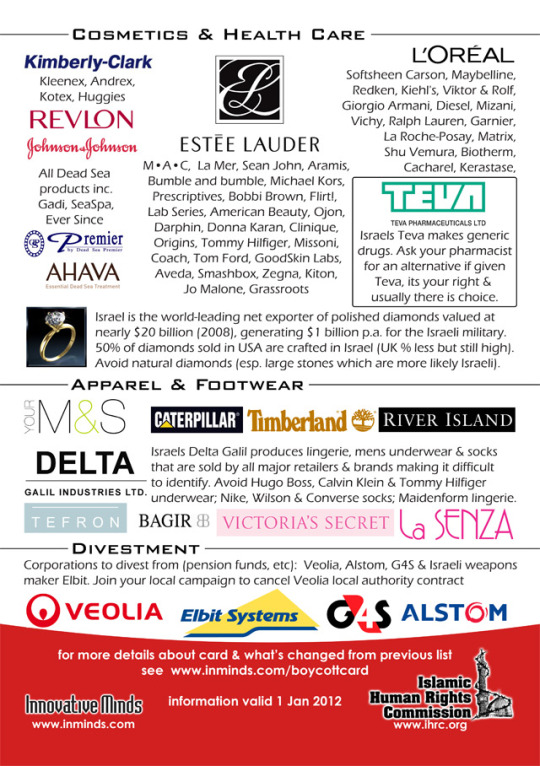
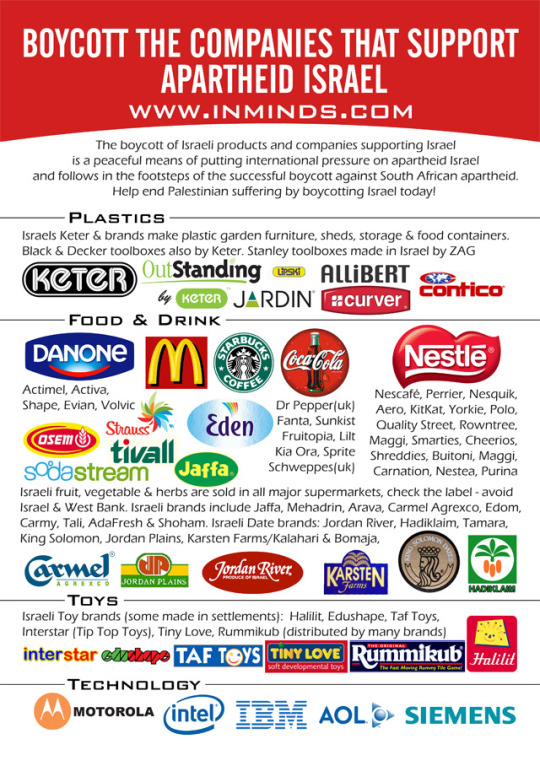


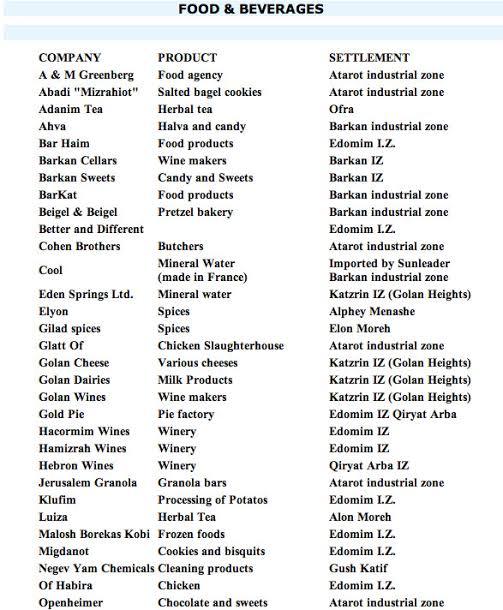

Israel barcodes number, don't buy anything that has numbers like these:

9 notes
·
View notes
Text
Vezlay Veg Chicken: Healthy and Tasty
Introduction
Vegetarianism and Vegan Food are on the rise, with more people seeking healthier and more sustainable food options. Enter Vezlay, a company that is revolutionizing plant-based diets with its innovative veg chicken products. But what exactly is Veg Chicken, and why is it becoming so popular? Let's dive in.
What is Veg Chicken?
Definition and Concept
Veg chicken is a plant-based alternative to traditional chicken. It's crafted to mimic the texture and taste of real chicken, providing a familiar experience for those transitioning to a vegetarian or vegan diet.
How It's Made
Vezlay's veg chicken is made from high-quality plant proteins such as soy and wheat. These proteins are processed and flavored to create a product that closely resembles the taste and texture of chicken.
Benefits of Veg Chicken
Health Benefits
Switching to veg chicken can offer numerous health benefits. It's typically lower in fat and calories compared to traditional chicken, making it a great option for those looking to maintain a healthy weight. Additionally, veg chicken is free from cholesterol and contains essential nutrients like fiber, vitamins, and minerals.
Environmental Benefits
Veg chicken is also better for the environment. Producing plant-based proteins requires less water and land compared to raising livestock. It also results in lower greenhouse gas emissions, making it a more sustainable choice for the planet. Vegetarianism and Vegan Food are on the rise, with more people seeking healthier and more sustainable food options.
Vezlay: A Pioneer in Veg Chicken
Company Background
Vezlay was founded with the mission to provide delicious and nutritious plant-based alternatives to meat. They have quickly become a leader in the industry, known for their high-quality products and commitment to innovation.
Mission and Vision
Vezlay aims to make plant-based eating accessible and enjoyable for everyone. Their vision is to create a healthier, more sustainable world by offering delicious and nutritious alternatives to meat.
Why Choose Vezlay's Veg Chicken?
Quality and Taste
One of the main reasons to choose Vezlay's veg chicken is its exceptional quality and taste. Made from the finest ingredients, it offers a satisfying and flavorful experience that can easily replace traditional chicken in any dish.
Nutritional Value
Vezlay's veg chicken is packed with nutrients. It provides a good source of protein, fiber, and essential vitamins and minerals. It's also low in fat and calories, making it a healthy choice for those looking to improve their diet.
Ingredients Used in Vezlay's Veg Chicken
List of Ingredients
Vezlay's veg chicken is made from a blend of soy protein, wheat protein, and natural flavors. These ingredients are carefully selected to ensure the best taste and nutritional value.
Health Benefits of These Ingredients
Soy protein is known for its high protein content and heart health benefits. Wheat protein adds a satisfying texture, while natural flavors provide a delicious taste without any artificial additives.

How to Cook Vezlay's Veg Chicken
Cooking Methods
Vezlay's veg chicken is versatile and can be cooked in a variety of ways. It can be grilled, sautéed, baked, or even fried. The cooking time is usually shorter than traditional chicken, making it a convenient option for quick meals.
Recipe Ideas
Veg Chicken Salad
Combine Vezlay's veg chicken with fresh greens, cherry tomatoes, cucumbers, and a light vinaigrette for a healthy and delicious salad.
Veg Chicken Stir-fry
Sauté Vezlay's veg chicken with bell peppers, broccoli, and soy sauce for a quick and flavorful stir-fry.
Veg Chicken Tacos
Use Vezlay's veg chicken as a filling for tacos. Top with avocado, salsa, and a squeeze of lime for a tasty and satisfying meal.
Healthy Recipes with Vezlay's Veg Chicken
Veg Chicken Salad
Combine Vezlay's veg chicken with fresh greens, cherry tomatoes, cucumbers, and a light vinaigrette for a healthy and delicious salad.
Veg Chicken Stir-fry
Sauté Vezlay's veg chicken with bell peppers, broccoli, and soy sauce for a quick and flavorful stir-fry.
Veg Chicken Tacos
Use Vezlay's veg chicken as a filling for tacos. Top with avocado, salsa, and a squeeze of lime for a tasty and satisfying meal.
Vezlay's Commitment to Sustainability
Sustainable Sourcing
Vezlay is committed to sustainable sourcing of their ingredients. They work with suppliers who follow eco-friendly practices, ensuring that their products have a minimal impact on the environment.
Eco-friendly Packaging
In addition to sustainable sourcing, Vezlay uses eco-friendly packaging for their products. This helps reduce waste and supports their mission to create a more sustainable world.
Customer Reviews and Testimonials
Positive Feedback from Customers
Vezlay's veg chicken has received rave reviews from customers. Many praise its taste and texture, noting that it makes the transition to a plant-based diet much easier.
Success Stories
There are numerous success stories from individuals who have improved their health and reduced their environmental footprint by switching to Vezlay's veg chicken. These testimonials highlight the positive impact of choosing plant-based alternatives.
Availability and Purchasing Options
Where to Buy
Vezlay's veg chicken is available at various grocery stores and health food shops. It's also available online, making it easy to incorporate into your diet no matter where you live.
Online and Offline Options
You can purchase Vezlay's veg chicken through their website or through major online retailers. It's also available in-store at select locations, providing flexibility for your shopping preferences.
Comparing Veg Chicken to Traditional Chicken
Nutritional Comparison
When comparing veg chicken to traditional chicken, you'll find that veg chicken is generally lower in fat and calories. It's also free from cholesterol and contains added fiber, making it a healthier option overall.
Taste Comparison
Many people are surprised by how similar veg chicken tastes to traditional chicken. Vezlay's veg chicken is crafted to provide a satisfying and flavorful experience, making it a great substitute in any recipe.
Common Myths About Veg Chicken
Debunking Myths and Misconceptions
There are several myths about veg chicken that need debunking. For example, some people believe that plant-based proteins are not as nutritious as meat. However, Vezlay's veg chicken is packed with essential nutrients, proving that plant-based alternatives can be just as healthy.
Future of Plant-Based Proteins
Trends and Predictions
The future of plant-based proteins looks bright. As more people become aware of the health and environmental benefits, the demand for products like Vezlay's veg chicken is expected to grow.
Vezlay's Role in the Future Market
Vezlay is poised to play a significant role in the future of plant-based proteins. With their commitment to quality and sustainability, they are well-positioned to meet the growing demand for healthy and delicious meat alternatives.
Conclusion
In conclusion, Vezlay's veg chicken offers a healthy, tasty, and sustainable alternative to traditional chicken. With its high nutritional value, exceptional taste, and commitment to the environment, it's no wonder that more people are making the switch to veg chicken. Whether you're looking to improve your health, reduce your environmental impact, or simply try something new, Vezlay's veg chicken is a great choice. Vegetarianism and Vegan Food are on the rise, with more people seeking healthier and more sustainable food options.
2 notes
·
View notes
Text
Nothing appears remarkable about a dish of fresh ravioli made with solein. It looks and tastes the same as normal pasta.
But the origins of the proteins which give it its full-bodied flavour are extraordinary: they come from Europe’s first factory dedicated to making human food from electricity and air.
The factory’s owner, Solar Foods, has started production at a site in Vantaa, near the Finnish capital of Helsinki, that will be able to produce 160 tonnes of food a year. It follows several years of experimenting at lab scale.
Solar Foods has already gained novel food approval for solein in Singapore, and is seeking to introduce its products in the US this autumn, followed by the EU by the end of 2025 – and the UK too, if the regulator can get through the deluge of cannabis-related products.
The factory’s output may be small in terms of the global food industry, but Pasi Vainikka, the Solar Foods co-founder and chief executive, hopes that proving its technology works will be a crucial step in revolutionising what humans eat.
Food and agriculture is responsible for about a quarter of all planet-heating carbon emissions. Its share of pollution is likely to grow as other industries shift to using green electricity, and ever-expanding middle-classes demand more meat for their tables. Up to now the focus for some climate campaigners has been to try to persuade people to eat less meat and more plants. Non-farmed proteins such as solein might make that approach more appealing.
Solein comes in the form of a yellowish powder made up of single-cell organisms, similar to yeast used in baking or beer-making. The company is hoping for those proteins to be used in meat alternatives, cheese and milkshakes, and as an egg replacement ingredient in noodles, pasta and mayonnaise.
The ravioli it served up this week was made with solein replacing egg, with a solein version of cream cheese. The Finnish confectioner Fazer has already sold chocolate bars in Singapore with added solein (which is also a handy source of iron for vegans). A Singaporean restaurant last year created a solein chocolate gelato, replacing dairy milk.
Vainikka was researching renewable energy systems at a Finnish research institute in 2014 when he met his co-founder, Juha-Pekka Pitkänen, a bioprocesses scientist. Pitkänen told him of soil-dwelling microbes that release the energy they need to live from oxidising hydrogen (rather than the glucose used by humans, for instance).
Together they built a 200-litre fermenter in a garage near Helsinki, to prove the technology could be used for food, but then went into the wild “finding new potatoes to grow”. All Vainikka will say on solein’s origins is that they found it somewhere “close to shore” in the Baltic Sea.
Almost all food consumed by humans at the moment ultimately comes from plants, which use energy from the sun for photosynthesis. That process converts carbon dioxide and water into the molecules they need to grow. Solar Foods instead uses the same renewable electricity from the sun to split water apart. It then feeds the hydrogen and oxygen to the microbes in a brewing vessel, plus carbon dioxide captured from the air from the company’s office ventilation system.
The claim that the proteins are made out of thin air is “never more than 95% true”, says Vainnika: 5% of the mixture in the brewing vessel is a solution containing other minerals needed by cells, such as iron, magnesium, calcium and phosphorus. The microbes are then pasteurised (killing them), then dried in a centrifuge and with hot air. That leaves a powder that can be used in food.
The process could also use CO2 from, for instance, burning fuels – although the molecule would end up back in the atmosphere once humans eat the solein and breathe out the carbon again. The real climate benefits from solein come from cutting the vast tracts of land used – and abused through deforestation on an epic scale – for animal feed and pasture. Instead, renewed forests could trap carbon.
Efficient US farmers get 3.3 tonnes of soya beans from each harvest of a hectare, according to the UN’s Food and Agriculture Organization. By contrast, Solar Foods’ pilot factory takes up a fifth of a hectare to produce 160 tonnes a year.
“As we can relieve pressures on agricultural land, they can rewild and return to being climate sinks,” Vainikka says.
Other companies are pursuing the same dream. Dozens are using microbes to create animal feed, although they often require sugars or fossil fuel feedstocks. One US rival, Air Protein, has opened a factory in California using similar “hydrogenotrophs” – hydrogen eaters. It has the backing of the food multinational Archer-Daniels-Midland, the British bank Barclays and GV (formerly Google Ventures).
The Dutch company Deep Branch, which is making fish food, claims its Proton protein will be 60% less carbon-intensive than conventional proteins. Deep Branch is looking at taking the CO2 produced by the UK biomass power generator Drax.
The companies have produced their test products. Now they face the challenge of proving their technology works at scale.
Vainikka says that is the key problem for cultured meat, or lab-grown meat. The market value of newly listed companies such as Beyond Meat soared during the coronavirus pandemic bubble, only to come crashing down as sales slumped. The opening of Solar Foods’ first factory will be crucial in persuading investors that the company will not suffer the same fate.
With meat protein, which is much more expensive than plants or cellular agriculture, there is simply no competition on price for each kilo. But Solar Foods and rivals could face other problems. Conservative politicians particularly in the US and Italy have identified lab-grown food as a threat to their ranching and farming cultures.
Vainikka argues that these fears are misplaced. He wants “coexistence of new and old”, with artisanal, high-quality farms remaining alongside cell farming that can deliver cheap, bulk foods. He argues it is “the opportunity of the century for the meat industry” to focus on quality rather than churning out as much cheap (and heavily subsidised) meat as possible. And plant agriculture will also remain, he argues.
“The future is not powder: the main body of food will still come through plants,” he says. The occasional “salami with the cultural heritage, that can remain. The meat in your lasagne during lunch will be done by cellular agriculture.”
3 notes
·
View notes
Note
That last anon answer has me wondering, what in your opinion is the best pellet out there?
At the present moment I don’t believe there is a best pellet. With current research we don’t even know what exact foods wild parrots we keep as pets eat. what vitamins and minerals are actually needed in what quantities for optimal health. Most of the data used to formulate diets for captive parrots is based off studies done on chickens. Pellets don’t run feeding trials and the singular one that claims they do won’t publish any data for consumers to make educated decisions.
We don’t have any of the data necessary to be able to say that there is one that checks the boxes better than another. Currently when selecting pellets the knowledge you’re using is as primal as “is this toxic” and “will this cause harm to the body over time” which is where we are able to make statements on fillers, dyes, and sugars.
I feed three different pellets currently for various reasons
TOPs - the ingredients are wholesome foods, no real fillers or additives, no synthetic vitamins (there’s no studies on whether or not a parrot can actually absorb and utilize synthetic vitamins currently, hypothetically they should and there’s nothing wrong with synthetic vitamins, we just do not have proper peer reviewed knowledge on how they interact in a parrot body) however there’s loads of concern over whether TOPs on its own supplies enough nutrients to be a full diet on its own.
Harrisons - it is formulated by a veterinarian (say about that what you will *cough* science diet debacles *cough*), does primarily use fillers but does also have slightly more hearty things like oats and barley, packed with vitamins that may be lacking in other formulations. Have flavour varieties, tougher texture, and much more varied sizes that can benefit more picky eaters. Frequently recommended by other vets, same company also creates liquid formulas for sick and ill birds. Overall does seem like they know what they’re doing.
Caitec - I primarily started feeding this because Newt is allergic to soy and this has very low soy and doesn’t yield a reaction from him. Has some filler but primarily uses oats, quinoa, millet, sunflower. Then you move in to the added vitamins and minerals. Unique crunchy texture, very palatable to my birds, very large size variety which is great for enrichment.
My choice to feed multiples is because of a safety fallback in case of recalls, I won’t be left feeding seeds trying to quickly do a pellet conversion if I have two other backups they can eat. But also to cover nutritional bases. We do not know what they need and I don’t wish to rely on one specific company to be doing everything just right to be providing optimal health for my birds, serving several will hopefully make it so if one pellet is lacking something one of the others will have it. And lastly is enrichment- various flavours, colours, textures and pellet size make meals more interesting and really liven up mealtimes.
There simply isn’t a perfect pellet because nobody knows what that would even look like.
When looking for a food to feed your bird the ultimately best thing to do is ask yourself “is this product made for the birds or to draw human interest”. Flashy colours, silly shapes, and potent sugars will primarily be used to attract your eye- not your birds. The sugars will make it palatable which converts the bird quickly and make the human happy. But the dyes and sugars are not ideal for long term health.
And secondly “how do birds do on this food” in the dog industry you would just get the paperwork from a feeding trial but for birds this means reading forums or sampling it for yourself. you can tell pretty quickly whether a food is doing your specific bird any good. Dull plumage, inconsistent droppings, weird food intake fluctuations, lack of energy, feather destructive behaviour, would all be potential signs that a food isn’t working for your bird (also potential signs of illness so y’know, correlation is not causation)
I did a deep dive last year where I contacted major pellet brands and tried to get any basic info out of them, you may want to read in to that if you want continued reading!
24 notes
·
View notes
Text






















World Milk Day
Start your day with a glass of calcium-rich milk, visit a local dairy farm, or see what milk alternatives like soy, oat, or almond milk you might enjoy.
It’s a well-known fact that milk is rich with calcium, a mineral that promotes healthy teeth and bones. June 1st is the date that has been set aside to celebrate Milk Day. And, of course, this is a celebration that can take place anywhere in the world, given that milk is a global food!
The use of milk in food and drink has been happening for thousands of years. As most people can appreciate, milk is an integral part of most people’s daily lives, and there’s an entire industry that revolves around it as well.
Milk is a liquid food rich with nutrients like calcium. It’s a food product that is primarily used by mammals during infancy. Although, in the case of humans, people tend to consume it in adulthood, as most adult humans can digest the lactose in milk.
Of course, milk isn’t only available for drinking. It’s an essential ingredient for dairy foods such as butter, cream, ice cream, and cheese. Milk can also be found as an ingredient used in other types of foods, such as bread, cakes, cereal, desserts and so much more.
There is no denying that milk has become a mainstay of most people’s diets today. It’s also one of the cheapest food products to buy, given the industrial scale of milk production in the world. Some of the largest producers of milk are the United States, India, and China.
History of Milk Day
Milk Day became a globally celebrated event on June 1st, 2001. The global celebration, in general, can be traced back to the United Nations (UN). In particular, the FAO (Food and Agriculture Organization) of the UN has been responsible for organizing and marketing World Milk Day throughout the globe.
More than two decades ago, the FAO proposed a global Milk Day to recognize the importance of milk and the role that it plays in our world. In addition, this day was also created to provide direct focus to the milk industry and publicize the various activities connected with it. In fact, the dairy industry supports the livelihoods of approximately 1 billion people throughout the world!
But even before this day was created in 2001, Milk Day was celebrated by some other nations throughout history. In the British Isles, for example, a Milk Day celebration (“Imbolc” – Celtic for “milk”) took place in the pre-Christian era.
Considering the fact that over six billion people worldwide consume milk and dairy, it’s no surprise there was a need to celebrate this healthy, delicious beverage!
How to Celebrate Milk Day
June 1st is a day that many people may want to write their diaries. Milk plays such a significant role in the world that should certainly be celebrated in style!
But what can be done to celebrate such a momentous occasion? Try out some of these ideas for enjoying Milk Day:
Get the Day Started with a Glass of Milk
Why not celebrate today with a glass of fresh, cold milk in the morning to kick-start the day?! But don’t stop there. How about enjoying a big bowl of cereal full of delicious milk?
Of course, after drinking that glass of milk, don’t forget to snap a photo of that beautiful milk mustache! Share it with the world on social media to remind everyone else to enjoy Milk Day too.
Join an Official Milk Day Celebration
As a worldwide event, Milk Day comes with all kinds of official opportunities to celebrate! In 2020, more than 400 Milk Day campaigns took place in over 68 countries all over the globe, so there should be plenty to join in with again this year. Here are some events that have taken place in previous years:
World Milk Day Milk Donation. Happening in New York State, USA, several organizations have gotten together to provide a free gallon of milk to the people in their local community who visit a dairy farm.
Live Recipes by Renowned Chefs from Around the World. This live Facebook event has been hosted by Amul, India, which is the country’s largest dairy brand, with the intention of showing the importance of milk throughout different countries and cultures.
International Dairy Federation Raise a Glass Event. Hosted by the IDF in Brussels, Belgium, this event involved hosting a toast to milk from people all around the world.
Check the World Milk Day website to get access to all the needed information to make plans for this day.
Visit a Local Dairy or Farm
For those who have some extra time, especially those with kids who are ready to learn, consider visiting a local dairy to learn the process of milking cows and collecting the milk. This will also lead to learning about pasteurizing and homogenizing milk, methods used to filter milk and keep it long-lasting.
If there are no cow farms nearby, consider visiting a smaller farm that has goats. It’s still possible to learn about everything milk-oriented but may be more accessible because they might be smaller and locally owned.
Enjoy Other Milk Products
For lunch, why not have a mozzarella or Margherita pizza and drink a glass of chocolate milk to wash it down? After that, those who are still feeling hungry could always have some delicious ice cream for dessert!
Other options for enjoying milk products on this day (and every day!) include yogurt, sour cream, butter, custard, cream and all of the recipes that can be made from them.
Try a Milk Alternative
For folks who have trouble digesting dairy easily, why not try other non-dairy milk alternatives? Here are some popular options:
Soy Milk. A favorite as one of the early milk alternatives, this one is made from soybean plants that grow fairly prolifically in many places.
Almond Milk. Made by crushing almonds and blending them with water, and then straining out the mix to remove any solids that are left, this nutty milk is filled with protein.
Coconut Milk. This one uses the white, fleshy part of the coconut, grating it and soaking it in water. The cream rises and is skimmed off, then what’s left is strained to extract the coconut milk.
Whether with a milk product or a dairy alternative, celebrating World Milk Day can be loads of fun!
Source
#chocolate cake#Rice pudding with cinnamon#flan de huevo#Pudim flan#Crème caramel#chocolate pie#whipped cream#dessert#Spain#travel#original photography#summer 2021#vacation#World Milk Day#1 June#WorldMilkDay#Princess cake#Strawberry Shortbread#USA#Strawberry Milkshake#Chocolate Banana Milkshake#Berries&Cream#Coconut Cream Pie#Banana Cream Pie#Strawberry Cheesecake Milkshake#Pecan Praline Milkshake#food#restaurant#Coconut Cream Pie Cheesecake#Pecan Pie
2 notes
·
View notes